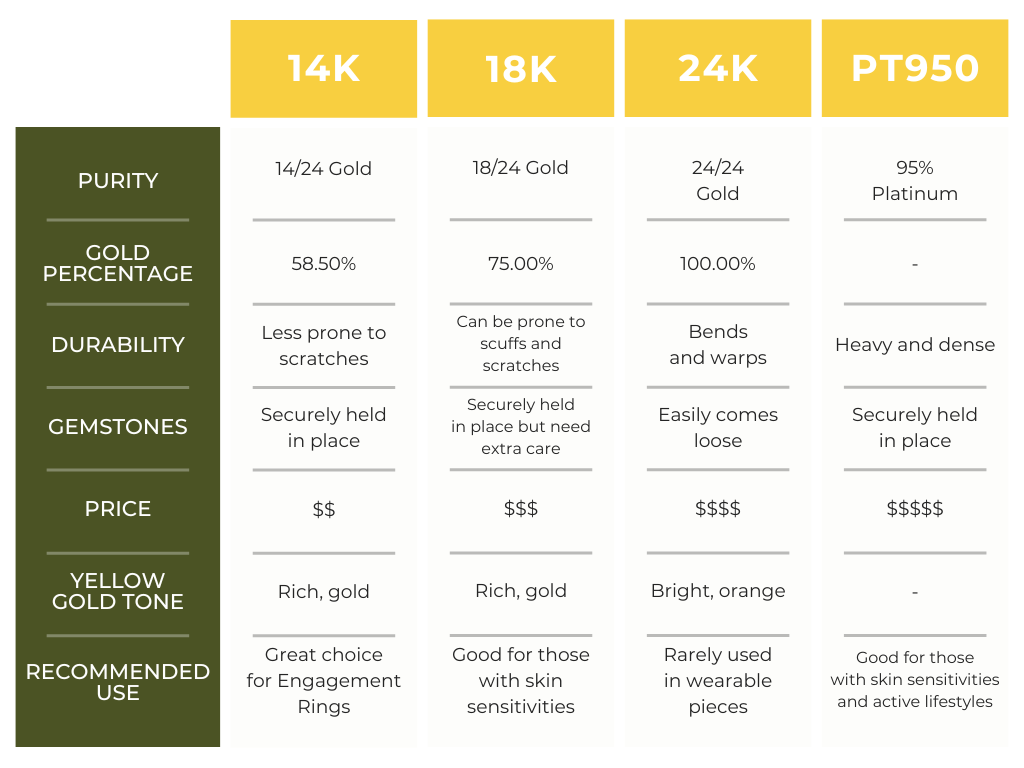14k, 18k, 24k Gold or Platinum Jewelry: Which One Should You Get?

Be it for an Engagement Ring, Wedding Band, or Fine Jewelry, solid gold is the metal of choice for most people. Known for its outstanding luster and shine, it has a classic look that withstands the test of time. Most gold jewelry pieces are sold in 14k, 18k, and 24k variants. But do you know what these terms mean?
Meanwhile, platinum jewelry is a premium option, perfect for those looking for a unique and extra-durable piece. Read further below to discover which choice is the best one for you.
Gold and Its Alloys

Biella Lab Diamond with a 1CT E VS1 Cushion Cut
Because gold is naturally soft, jewelers mix it with other metals to make it wearable and long-lasting. These alloys also make way for popular jewelry colors like White Gold and Rose Gold.
14k and 18k gold are among those alloys. Meanwhile, 24k gold is the metal's purest and most delicate form. Our table below summarizes their differences to platinum for a quick comparison.

14k, 18k, 24k Gold, vs Platinum
14K GOLD

Sapienza Lab Diamond with a 1.5CT E VS1 Princess Cut in White Gold
This gold alloy is your best bet for jewelry that you'll wear day in and out—an Engagement Ring, Wedding Band, or maybe a classic necklace you never want to take off. It is also the perfect choice for men and women with active lifestyles.
Its scratch-resistant property gives it the perfect balance between durability and purity. 14k gold is firm and can securely hold gemstones like Moissanite and lab-grown diamonds for your peace of mind. When choosing a yellow gold piece, 14-karat jewelry also has a sophisticated color that most adore.
18K GOLD

Lucia Lab Diamond with a 0.75CT G VS1 Oval Cut in Yellow Gold
Meanwhile, we recommend 18k gold when looking for one-of-a-kind pieces for life's momentous events—unique jewelry for special occasions. Since it contains more gold, it's more susceptible to scruffs and scratches, requiring extra care when worn.
This alloy is also your best bet if you're prone to allergies when in contact with metals like nickel. Since gold is naturally hypoallergenic, jewelry pieces with higher purity mean fewer skin sensitivities.
24K GOLD

Jamila Ring with a 1.95CT (8mm) SUPERNOVA Moissanite
Lastly, 24k gold is only recommended when looking for investment pieces—something to admire and keep as it increases its value. As mentioned above, this is gold's purest and softest form, which makes it incompatible with jewelry pieces.
PLATINUM

Presa Lab Diamond with a 1CT D VVS2 in Platinum
Finally, platinum is a naturally white metal. It is heavier and denser, making it a durable material for cradling your gemstones. Due to this characteristic, platinum possesses a much heftier price compared to gold—a premium choice for a love that gives it all. Platinum is also a naturally hypoallergenic metal, making it a great option for those with skin sensitivities to gold alloys.
What's Next?
Now that you know the difference, are you going for a Yellow, White, Rose Gold, or Platinum piece? Click HERE to read our Style Guide in Choosing the Right Tone for Your Engagement Ring.
